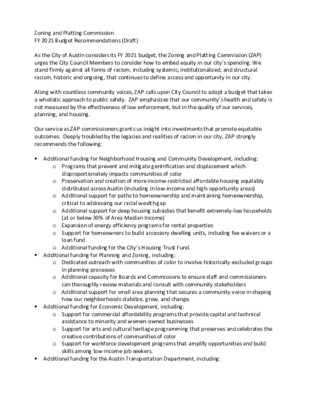E 02 (07172020 DRAFT ZAP Budget Recommendations) — original pdf
Backup

Zoning and Platting Commission FY 2021 Budget Recommendations (Draft) As the City of Austin considers its FY 2021 budget, the Zoning and Platting Commission (ZAP) urges the City Council Members to consider how to embed equity in our city’s spending. We stand firmly against all forms of racism, including systemic, institutionalized, and structural racism, historic and ongoing, that continues to define access and opportunity in our city. Along with countless community voices, ZAP calls upon City Council to adopt a budget that takes a wholistic approach to public safety. ZAP emphasizes that our community’s health and safety is not measured by the effectiveness of law enforcement, but in the quality of our services, planning, and housing. Our service as ZAP commissioners grants us insight into investments that promote equitable outcomes. Deeply troubled by the legacies and realities of racism in our city, ZAP strongly recommends the following: Additional funding for Neighborhood Housing and Community Development, including: o Programs that prevent and mitigate gentrification and displacement which disproportionately impacts communities of color o Preservation and creation of more income-restricted affordable housing equitably distributed across Austin (including in low-income and high-opportunity areas) o Additional support for paths to homeownership and maintaining homeownership, critical to addressing our racial wealth gap o Additional support for deep housing subsidies that benefit extremely-low households (at or below 30% of Area Median Income) o Expansion of energy efficiency programs for rental properties o Support for homeowners to build accessory dwelling units, including fee waivers or a loan fund o Additional funding for the City’s Housing Trust Fund. Additional funding for Planning and Zoning, including: o Dedicated outreach with communities of color to involve historically-excluded groups in planning processes o Additional capacity for Boards and Commissions to ensure staff and commissioners can thoroughly review materials and consult with community stakeholders o Additional support for small area planning that secures a community voice in shaping how our neighborhoods stabilize, grow, and change. Additional funding for Economic Development, including: o Support for commercial affordability programs that provide capital and technical assistance to minority and women-owned businesses o Support for arts and cultural heritage programming that preserves and celebrates the creative contributions of communities of color o Support for workforce development programs that amplify opportunities and build skills among low-income job seekers. Additional funding for the Austin Transportation Department, including: o o Increased funding for sidewalk improvements to improve transit access in areas with high ridership Inclusion of equity metrics for project prioritization to support investment in communities of color. Across all City of Austin departments: o Dedicated resources for public engagement that seeks out and lifts up marginalized voices, including an annual report with measurable outcomes to demonstrate the City’s response to feedback received during outreach with communities of color. The annual report shall be reviewed by the Equity Office o Develop and improve digital community engagement that promotes equitable and inclusive participation in public meetings o Equitable allocation of all budgets, services, bonds, and capital investments to communities of color in order to address historical discrimination and neglect (resulting in today’s low and very-low opportunity areas) and ensure each neighborhood has opportunities equal to those in Austin’s high-income neighborhoods o Develop internal program requiring all current City staff participate in and complete the Undoing Racism Training within 12 months (if they have not already participated) and requiring new employees to complete this training within 6 months of hire Inclusion of equity metrics in Capital Improvement Program for all infrastructure improvements, to support investment in communities of color (including but not limited to drainage, streets, and utilities). o